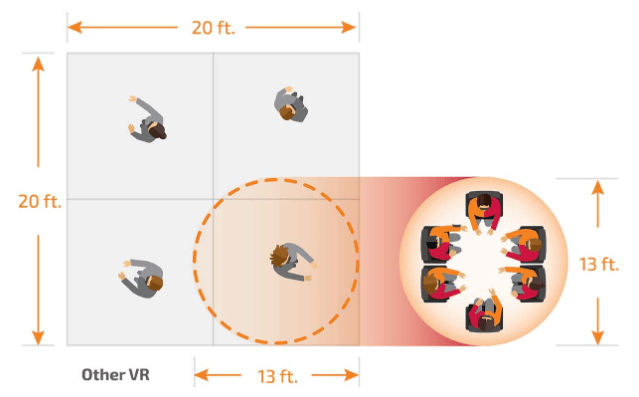What is a VR Escape Room?
An introduction to how virtual reality can redefine the escape room as we know it.
You enter the room, and the door slams shut behind you.
Then, without warning, an axe flies out of nowhere, missing two of you by inches…
A very dramatic - and suitable - beginning to an escape room mission, right?
The only problem is, a real axe flying at the team members will put them in danger, and you can’t really do that, in a real life escape room.
But you can do it in a VR Escape Room.
You can simulate the event of an axe flying at team members, but without exposing them to any real danger.
And that, in a nutshell, is the key advantage of a VR Escape Room - it allows you to create an escape experience that would have been impossible,or at least very difficult, in real life.
[toc]
What is Virtual Reality?

Virtual Reality is an experience that may bear as much or as little resemblance with the real world as is desired.
It allows the user to interact with a simulated environment through various kinds of input (I will revisit this in a bit).
Think how shooting a movie kept evolving with general advances in technology - from black and white, stuttering affairs (which were a novelty of their time) to going 3D and consulting with experts to create sets, props, and special effects.
It’s all aimed at placing the user in the hot seat, in the thick of the action, so they can ‘live the event’.
Why is Virtual Reality a fit for Escape Rooms?

There are three main reasons why Virtual Reality is a good fit for Escape Rooms:
- Immersion,
- Range of experiences, and
- Removes some challenges of running a traditional Escape Room
Immersion

Cori Anderson (renowned Art and Culture writer) defines immersion as ‘the creation of a world around the person in a way that makes them feel part of and inside of it’.
It makes the participant an active stakeholder in the experience, as opposed to being merely a passive observer.
If you think about it, that’s a core feature of an Escape Room - create a make-believe world for the escape team to lose themselves in.
It’s the feature that makes team building in an Escape Room so effective; by making the team believe that they are in the Escape Room world, it gives them a stake in the final outcome - whether they can find their way out of in time.
And immersion, if you think about it, is THE defining feature of Virtual Reality - creating an alternate reality for the user to live in and interact with.
Range of experiences

Players experience zero-gravity flight, shoot lasers, fight against hostile robots, and use telekinesis…
That’s from the actual description of Space Heroes - one of the VR Escape Games offered by Entermission.
Could zero-gravity flight and telekinesis effects be achieved in a traditional Escape Room?
And, even for effects and experiences that may be offered in a traditional Escape Room, a Virtual Reality Escape Room would be able to bring them to life a lot better, due to the extensive system of inputs that runs the experience. More on this in a few minutes.
Removes some challenges of running a traditional Escape Room
Prop damage, and prop wear and tear
One of the main problems faced by traditional Escape Rooms is prop damage.
Players may try to force something that’s meant to be opened via logic, simply from adrenalin, resulting in breakage.
Even a decorative prop could be damaged inadvertently.

None of these issues will arise in a VR Escape Room - because there ARE no props!
The entire experience is a computer program.
Sometimes, it’s not damage, but wear and tear that degrades props over time. Once again, a VR escape game removes that worry.
Space constraints
Recreating the escape scenario in real life will take up space - space for which, unfortunately, rent will need to be paid.

Breaking into a room scenarios could be staged in an average sized room; however something like escape the haunted school would ideally need a large room, or multiple rooms for a realistic staging.
Whereas, were you to open a VR Escape Room, one entire escape room could be housed within a 170 sq. ft. space, compared with 4 players wandering around a 400 sq. ft. space in a traditional Escape Room. In other words, a VR Escape Room helps you get more profits per unit area of your premises.

It also helps you overcome space constraints - for example, while remaining in the same 170 sq.ft. area, players could traverse from one setting to another, say from a desert to a forest.
The same switch in a traditional Escape Room would require two separate rooms.
VR Escape Rooms involve multiple kinds of input
The key selling point of many a VR escape room franchise (including Entermission) is a ‘multi-sensory experience’, that is, an experience that involves most, if not all the five senses - sight, sound, smell, taste, and touch.
Accordingly, a VR escape experience will involve multiple kinds of input for the player:
- Visual
- Audio
- Olfactory (smells)
- Haptic (touch)
It is this extensive gamut of inputs that makes the virtual world ‘come alive’ to the players.
VR Escape Rooms involve multiple kinds of input
The key selling point of many a VR escape room franchise (including Entermission) is a ‘multi-sensory experience’, that is, an experience that involves most, if not all the five senses - sight, sound, smell, taste, and touch.
Accordingly, a VR escape experience will involve multiple kinds of input for the player:
- Visual
- Audio
- Olfactory (smells)
- Haptic (touch)
It is this extensive gamut of inputs that makes the virtual world ‘come alive’ to the players.
Equipment, a VR Escape Room would need
The equipment a VR Escape Room needs fall roughly under 3 categories
Equipment to create the multi-sensory experience
- Headsets, LED accent lighting - for visuals
- Haptic device - like a special transducer, for creating the sensation of touch
- Wind generator, heat generator - to make the experience even more real life
- Scent generator - for olfactory (smells) input
Equipment to deliver the experience
At its base, a VR escape experience is a computer program. To run the program successfully, you need
- A VR core
- A hand tracking device - which tells the computer how the player is acting, so the next stage of the game can be configured accordingly
Other, practical equipment
- UV cleansing wand and cleansing spray / wipes - to clean the headsets
- Back-up face foam for VR headsets, equipment and cabling - that’s the only bit of a VR Escape Room that may be exposed to wear and tear, so you need to keep some in reserve
The various VR Center Formats
If you’re serious about starting a VR Escape Room, or an VR Gaming Center, you’ll need to draw up a business plan. And one of the first things you’ll need to decide is, what kind of a VR Escape Room do you want?
- VR Arcade - It features a series of VR terminals one after another, with each terminal offering the entire menu of games you have. Players book a time slot at a terminal, and play whichever game(s) they want to.
- VR-only Escape Room - Players book an entire room, which may feature a single game or a menu of games. Each room will have chairs for the players to sit on, VR headsets, controllers and headphones. The entire experience will be in the virtual world.
- Hybrid VR Escape Rooms - Here too, players will book an entire room. However, in addition to chairs, headsets, controllers and headphones, a hybrid VR Escape Room will also feature real world inputs. For example, an explosion simulation will feature the chairs rumbling, wind and heat blowing into the face, and even a smell of gunpowder.
Where can VR Escape Rooms prove useful
The key aspect of a VR Escape Room is the incredibly high level of immersion, and the wide range of inputs that can trigger various senses.
A more immersive and interactive experience
The participant can engage a lot more with the experience, via the computer program running the escape game.
And, the multisensory input system offers a well-rounded experience, coming very close to the ‘doing something tangible’ quality that a lot of enthusiasts cite as the reason escape rooms are so popular in the first place.

These qualities are bound to make it popular among the ‘family friendly things to do’, ‘birthday party activity’ and ‘corporate event’ demographics.
Team building in VR Escape Rooms

By giving people a stake in the outcome, a VR Escape Room can be a good option for organizing a team building event.
Why?
Because, having a stake in the outcome gives participants an incentive to take part in the activity wholeheartedly.
Training in a VR Escape Room
The wide range of inputs that can be given - wind, temperature, different kinds of video and audio - can be very useful in simulating real-life situations, while removing real-life dangers from the equation.

So, for example, if you’re training a pilot, an escape experience can train them to face various kinds of critical situations, very realistically, giving them almost ‘practical experience’.
To sum up,
The core of a Virtual Reality Escape Room is immersion.
You can control various kinds of input to the player, creating a multi-sensory experience that is, well, virtually real.
This not only makes a VR Escape Room a top draw for ‘an evening out’, but also makes it very important for team building events and training exercises.
If you are interested in starting a VR Reality Room you can learn more about Entermission VR Escape Room Licensing and Franchising here.
